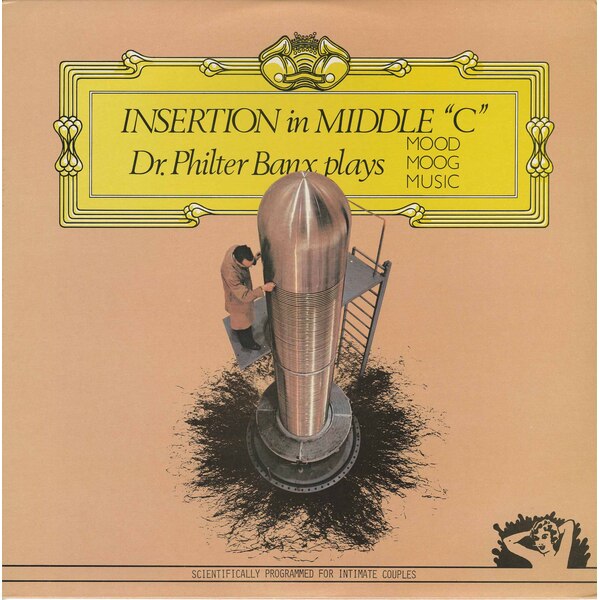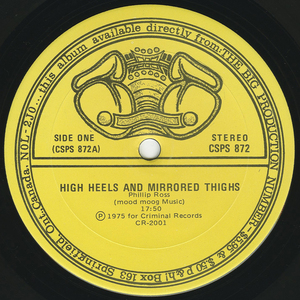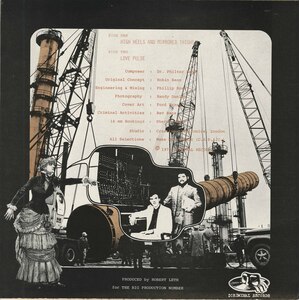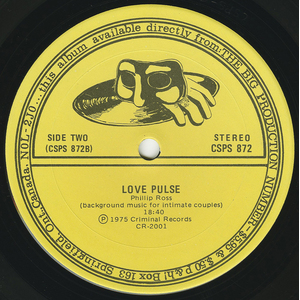Information/Write-up
Dr Philter Banx – Insertion in middle “C” was a studio project recorded by a student collective who were attending Fanshawe College in 1975, in London, Ontario. It was recorded at Creative Electronics Studio, an 8 track recording studio located at the College, which was one of a only a handful of recording studios in the area at that time. Marshal Mcluhan’s son, Eric McLuhan, was the instructor at the College. The students were enrolled in the first post-secondary program for teaching Recording Music Techniques, specifically electronic music, which was gaining popularity at that time.
Back in the romantic period of 1975, the average mating cycle of a typical heterosexual human interlude lasted 22 minutes; the amount of time which coincided with the length of time one side of an LP will play. And thus was the impetus for the “Insertion” project. On Side A, the music starts out as slow as smooth jelly will roll away on a smooth naked belly; over time, it organically cultivates until it reaches an exhilarating climax. The flip side of course is the serenity of the afterglow.
Phil Ross was the original “Doctor Phil” and was the key musician for the project. He was the “Phil” in “Dr. Philter Banx”; a spoonerism technique of the filter bank, a component that controls the separation of signals that pass through filters. Indeed, the Engineering of the zygote and mixing of the spermatozoa was by Phil Ross. For a more exciting sensation during penetration, the good doctor has etched ribs into the metal object. We observe that the metal fragments have accumulated, becoming the ring zone.
“Insertion of Middle C” could be construed as the insertion point of the needle on the vinyl grooves. Thus, this album should be well lubricated whereas the listener should be only partially inebriated. The album was recorded when sound waves were produced to create a mild aphrodisiac, way before the invention of sexual chemicals hatched by the Farmersuiticals. A normal person should take 4 minutes to become aroused. Should arousal not occur, seek out a Farmer.
The sperm capacitation was injected by Dr. Philter Banx and Robin Banx (named after Robert Leth's newborn son - now Rob Leth, reporter on Global TV, Toronto), who were the originators of the gamete transport concept, acrosome and zona reaction.
The photography was by Randy Dunlop.
The stunning and original cover artwork was by Ford Evans.
Mr. Robert Leth was the producer of the album for the Big Production Number. Robert was a recording engineer from 1975 through 1990. He also produced Stan Roger’s first three albums as well as the first Canadian celtic rock song, “Oh, No, Not I”, which was on Stan Roger’s 1978 album “Turn Around”. Robert Leth now resides in Halifax and works in the sustainable energy industry (wind farms).
The album was released on the students own private label Criminal Records (the only recording on the label). It was sold locally and appeared on the shelves of local record stores and was also available by mail order through Rolling Stone Magazine.
Upon release of the album, and an initial successful first pressing of around 500 copies at most, Dr. Philter Banx team had thought a second pressing was in order. That idea was quickly quashed when the Deutsche Gramophon company contested the validity of the album. They claimed that the album was mocking their label and that Dr. Philter Banx utilized their floral frame design. Although the claim was hogwash, the financially challenged students relented when they were hit with a Cease and Desist Order by the German recording label; ordering them to appear in court in Dusseldorf. The team decided to cut and run, and so the album lay dormant for 35 years.
Copies of “Insertion in Middle “C”” have resurfaced quite regularly over the past 35 years. There was a flurry of activity surrounding this album around 4 years ago. At the time, it was changing hands for around $200 to 300, and reportedly the album fetched $1,000.00, after a club DJ in New York who went by the handle “Green Tea” started tea-totaling it (sampling).
Now, the album has once again sparked some significant excitement and, due to pent-up demand from the general pubic, it is being released exclusively to the millions by way of virtual download. The Museum of Canadian Music and Mr. Robert Leth are making this great album available for the very first time since 1975.
We think you will find this remarkable pioneering scientific recording quite stimulating.
This album is available exclusively to this website. The recording was made from a first-play, previously sealed copy of the album.
-Robert Williston, February 2011





No Comments